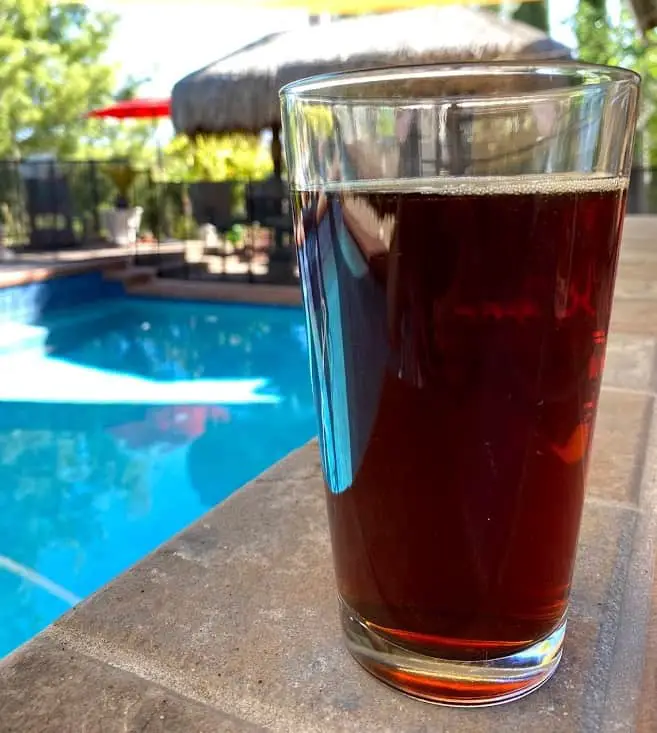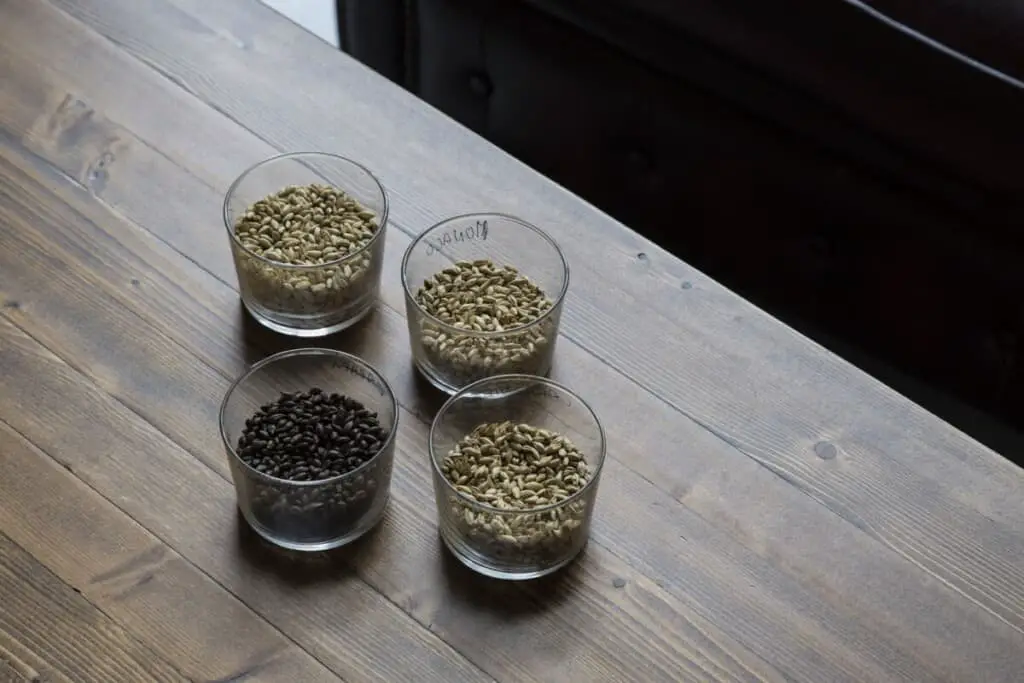
Are you about to take your first walk into the world of all-grain? If so this simple amber ale recipe could be just what you need in order to brew a fantastic amber ale that your friends will remember.
Simple Amber Ale Recipe
For 5 gallons of Simple Amber Ale You will Need:
- 6 lbs American 2-row Malt
- 2 lbs Caramel Crystal Malt 60L
- .5 lb Munich Malt 10L
- 2 oz Cascade Hops (1 oz at 60 min. 1 oz at 15 min.)
- California Ale Yeast WLP001
This recipe will result in a 4.5% beer with 72% brew house efficiency with an IBU level of 30.
Click here to visit Adventures in Homebrewing to find and purchase the above ingredients.
Check out this YouTube Video I did documenting my process if you want to attempt it yourself. I promise I’m not as crazy as the thumbnail makes me look.
The above Simple Amber Ale Recipe will be enough to get you started. It falls within the style guidelines but might be a bit basic, read below for more information on how to create epic variations.
Amber Ale Style Guidelines
Amber ales are uniquely American, the style was essentially perfected in the Pacific Northwest. Many believe it started from a pale ale style and morphed into something a bit maltier utilizing more caramel style malts and flavors.
According the the BJCP guidelines an American amber/red ale is copper or reddish in color. It has high levels of malt and caramel flavor. It includes American hop varieties with lower aroma and flavors. Lower fruity esters are present from yeast but don’t need to be entirely absent.
I’ve often wondered how this differed from the Irish red ales I love so much. What it comes down to is the hops, there is no hop aroma in an Irish Red but a noticeable hop aroma in an American amber. So you can really be free to highlight the citrus forward hops if you so choose.

Amber Ale Grain Build and Malt Profile
When it comes to base malt on an American amber ale its relatively basic. You will want to include American 2-row pale malt. This base grain will take up probably anywhere from 40-90 percent of your grist profile.
The more base malt that you have the less of a red copper color you will get. That’s why it’s important to balance specialty and crystal malts to achieve the desired color.
I really hesitate to lean into any base malt range, because ultimately there are a ton of variations when it comes to an American amber ale recipe. If you are looking to go more simple I would lean somewhere into the 70-80 percent range.
This way you are not focusing on too many specialty malts to help achieve the color, which could result in a cocktail of unknown flavors.

Caramel Crystal Malts: The Star Player of Amber Ales
When it comes to specialty malts, this is where the Amber ale really shines. You will need to include Caramel Crystal malt in some degree in order to achieve the desired copper color. The lovibond level will lie somewhere between 40-60.
This malt will not only provide the color associated with the style but it will also give you that biscuit and caramel taste. Using a clean yeast will help to promote this flavor rather than transform it.
Beware of Hop Oxidation with Crystal Malt
Be wary of utilizing too many hops in conjunction with a large amount of caramel crystal hops. For some reason many craft brewers agree that they have a detrimental effect on hops and promote oxidation. Nobody knows exactly why but there is a lot of breweries that agree.
Because of the issues with hops and caramel crystal malt, if you want to go hoppier then make sure you use alternative malt or higher levels of base malt.
Check out this video below for some excellent substitutions for crystal malt.
However, if you are planning on drinking the beer fairly quickly you won’t need to worry too much, just make sure you aren’t trying to age it more than a year.
Additional Specialty Malts
Specialty malts can play a big role in differentiating your beer flavor profile, just make sure you don’t go too crazy on your first try.
When it comes to alternative malt you can use some of the following:
| Specialty Malt | Flavor Profile |
|---|---|
| Victory Malt | Adds a bready toasted biscuit flavor, adds dry complexity. |
| Munich Malt | Can be used as a base malt for other styles, typically 10L. Adds color and malty complexity. |
| Maris Otter | This is an English style base grain that adds some golden color and a rich nutty flavor. |
| Chocolate Malt | Adds a chocolate or raisin flavor. Could be desirable to pronounce the raisin flavor in an Amber ale. Use sparingly as not to darken the Amber color too much. |
When it comes to producing a delicious Amber maltiness, you have a lot of flexibility. Just make sure to keep the color in check. This can be done by monitoring the Lovibond levels that you are using. Lovibond refers to the color a malt has been toasted too.
Hop Styles and Characteristics in an American Amber Ale
When brewing an American amber you will need some American hops. You can really experiment a lot here as long as you balance the hop IBUs with the style guidelines.
This means you will need to keep within the 25-45 IBU range. So depending on the amount of grains that you are using you need to adjust the hop quantities and boil addition accordingly.
| Hop Type | Description | Alpha Acids / bitterness |
|---|---|---|
| Amarillo | floral, tropical/grapefruit and citrus. Great flavor and aroma. | 6-9 percent alpha acids |
| Cascade | Originally from Oregon. Use this hop if you want a true to the style flavor. Citrus, grapefruit and spice. | 4-9 percent alpha acids |
| Centennial | Bittering hop. Citrus and flower aroma evident, high bitterness. | 9-12 Percent Alpha Acids |
| Columbus | Earthy and faint citrus character, used for american ales. Clean bittering. | 14-16 percent alpha acids and |
Alpha acids are where the hop aroma and bittering ability come from. The higher the alpha acids the more IBU you can achieve with less hops. The IBUs or bitter flavor comes from the alpha acids being boiled, a reaction is taking place.
In order to get more aroma and less bitterness you can add the hops later in the boil.
If you want to learn more about how long hops last and how age can affect hop alpha acids check out my article on how to know if hop pellets are bad.
Yeast Choice Should Be Clean or Mildly Fruity
When it comes to yeast the most preferred for an American Amber Ale style is a California Ale Yeast. You can either use WLP001 or Wyeast 1056 American Ale.
These yeast types have a high alcohol tolerance so you will need to make sure to use the appropriate amounts of malt to achieve your desired flavor. The yeast profile is clean so it will not contribute fruity esters, so the malt and hops are more the stars of the show.
Alternative Yeast Styles for American Amber
According to the style guidelines there can actually be mild fruitiness so you don’t have to use the cleanest yeast shown above. In fact one might prefer a higher flocculating yeast to achieve a clearer beer to truly highlight the color.
One yeast style that might be beneficial to use is WLP002 or any English style ale yeast with high flocculation. It also produces mild fruity character which is acceptable in the style.
Play Around with Proportions and Ingredients
I find it fun to create recipes, you can make sure you fall within style guidelines by using certain programs. Although since you are a frugal homebrewer feel free to break the rules.
The one that I used to come up with the simple Amber ale above, and my super secret Amber ale recipe is Beersmith. You can download it from Beersmith.com.
Directions on Brewing All-Grain Amber Ale Recipe
It would be a lot of writing to explain everything you need to do when brewing an all-grain recipe, but luckily I wrote an article that does just that. Check out my all-grain sparge method!
Now as for directions when brewing an American Amber Ale Follow Below.
Mashing Temperature

For an American amber ale you will need to be in the higher range for mash temperature. The range will typically be from 154F to 158F. This will create a beer with medium to high body. Which is important in the style.
Its a single step mash, which essentially means you keep the mash temperature constant for the full duration. This makes it simple for new all-grain brewers to manage. Unlike many wheat mashes.
Hop Additions
Depending on what hops you are using you can add the hops at different times. If its just to balance the malt flavor then you can go strictly off bitterness. If instead you want to highlight some hop flavors or aroma then later boil additions will make sense.
The initial recipe we began with is a standard practice hop addition schedule.
Fermentation Temperature and Time
Depending on what yeast you use, will decide on what the perfect fermentation temperature should be. They typically have a range and the lower in that range you are the more clean the yeast will be.
If you have the means I suggest hitting that lower end of the range to hide any fruity esters your yeast may have.
As for fermentation time, it really depends on when the yeast is done eating the sugars from the grain. You can check to see if the yeast is done if the gravity does not change for a few days. This typically takes anywhere from one to two weeks.
At that point you can keg carbonate and drink, or wait another two weeks to bottle condition.
What We Learned About American Amber Ales
American amber ales are truly a malt forward American style beer. The have the signature American hops developed in the Pacific northwest as a counterweight to to malt.
If you found this article helpful consider bookmarking it to save for later or share with a friend who loves American amber ales.
Also remember if you want to buy any of the ingredients on the list consider buying from
